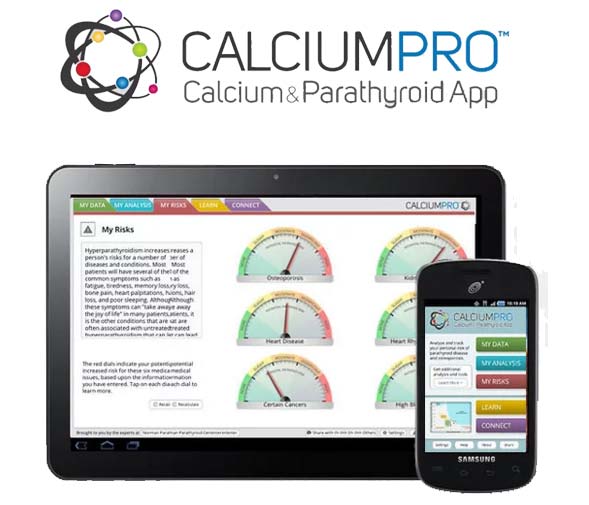Parathyroid disease (Hyperparathyroidism) is quite simple in the vast majority of patients. Most patients will have only one parathyroid tumor, however, about 28 to 30% will have more than one parathyroid tumor. Since your surgeon can't tell before the operation who will have one parathyroid tumor and who will have two (or even three), he/she should look at all four parathyroid glands during your operation. There is no way for your surgeon to tell how many bad parathyroid glands exist without examining each of them--don't let them tell you that they can measure the hormone in the operating room to see if the hormone drops--that doesn't work or we would be doing it. Usually the parathyroid tumors about the size of a peanut or olive. If they are a decade old or more (and your doctors have been asleep for a few years), they can be the size of a grape. Parathyroid tumors are benign (non-cancerous) which we call an "adenoma". This page assumes you know some basic information about parathyroid disease.
-
You should already know that all humans (dogs, cats, horses, cows, deer, antelope, pigs, elephants, giraffes, etc, etc, etc) have 4 parathyroid glands. All mammals have 4 parathyroid glands.
-
You should already know that hyperparathyroidism is a disease caused by the over-production of parathyroid hormone (PTH). It is this hormone that circulates in the blood removing calcium from the bones and puts the calcium into the blood. It is the high calcium in the blood that causes all of the symptoms and problems. The high calcium in the blood came from the bones--the calcium is being leeched from the bones.
-
You should already know that the majority of cases of parathyroid disease are caused by a single bad parathyroid gland... a benign tumor called a "parathyroid adenoma" This tumor will continue to grow and make your disease worse and worse until it is removed. Parathyroid adenomas will NEVER go away on their own. They will NEVER decrease in size on their own. They are TUMORS that must be removed. They are NOT cancer, they are benign tumors that make uncontrolled amounts of hormone. Click here to see lots of pictures of parathyroid adenomas.
-
This disease is very simple and very easy to fix in almost all patients. Be careful if your doctors tell you this is hard and dangerous to fix. Things have changed over the past 10 years! If you get an expert surgeon, hyperparathyroidism is almost always very easy to cure.
In Review: About 70-75% of patients with primary hyperparathyroidism (parathyroid disease) have just one parathyroid gland that has grown into a tumor. This means that the other three parathyroid glands are normal. The single bad parathyroid gland is called a "parathyroid adenoma". This is a benign tumor -- get a surgeon to remove it and you are cured.
But be careful, if your surgeon takes out the one tumor and quits the operation without looking at the other 3 parathyroid glands you may not be cured. There is no way to determine who has only one parathyroid adenoma prior to the operation. No scan can tell you this (please, stop relying on the scans!). If your surgeon removes only one tumor and quits the operation you may be one of the 25-30% who have more than one parathyroid tumor and then you won't get better, and you won't feel better (and you will need a second operation to remove the second parathyroid adenoma). This concept is illustrated beautifully in the video of Dr Norman performing a parathyroid operation--the scan on this patient shows one tumor but he had two!
Measuring Parathyroid Hormone in the Operating Room
If your surgeon says he/she will "measure the PTH hormone to see if it drops by 50% or more and this will tell me that there are no other tumors present", then be careful. We NEVER use this test because it takes at least 45 minutes to run and it is inaccurate at least 15% of the time. Can you name a test that we use for ANYTHING in life that is inaccurate 15% of the time? There is no other test in medicine (or engineering, accounting, mathematics, physics, chemistry, or any other aspect of life) that is wrong 15-20% of the time. So be careful if your surgeon tells you that he/she will rely on this test to determine if you are cured. Just ask them--and have them look you in the eye when they answer: Does this "Intraoperative PTH assay" test always work? Have you ever seen this test not work? Has this test ever made you do something during the operation that you regret? Has this test ever made you hurt a patient because it was wrong? Folks, be careful relying on a surgeon who relies on a test that is wrong so much of the time. We do thousands of parathyroid operations per year--if this test worked we'd use it. Be smart out there! We operate on several patients every day that were not cured because they had an inexperienced surgeon operate on them previously who used this test.
Dr Norman wrote a great blog on the topic of surgeons only looking at one parathyroid gland and quitting the operation. Read it here. If your surgeon is not going to look at all four parathyroid glands there is only ONE reason why -- he / she cannot do it safely. That's it. If they could, they would.
Mini parathyroid surgery is NOT only for those with a positive scan if you have an expert parathyroid surgeon who does many parathyroid operations. The biggest mistake we see (besides not diagnosing parathyroid disease correctly) is that patients will get a poor quality sestamibi scan which doesn't show a tumor and their doctors will tell them that they likely have four bad parathyroid glands (hyperplasia), and therefore the operation is more difficult and can't be done as a mini operation. This is not true! It depends on the surgeon. We do mini-surgery on 100% of patients regardless of the scan results. Geeezeee, folks, stop getting scans! Scans are wrong more than they are right! And Geeezeee folks, stop taking advice from a doctor that you clearly know more than about concerning this topic. If you are reading this page, then you have already read a half dozen other pages on this website, and therefore you will know more about hyperparathyroidism than 90% of endocrinologists. It's sad, but if you are reading this, then you know it is true.
Here are a few facts about parathyroid surgery and the differences between the 70% of patients with one parathyroid tumor vs. the 30% with two parathyroid tumors, and the 1.5% with 4 bad glands.
-
We stopped performing one-side operations in 2005 because a large percentage of patients are not cured and will need a second operation. A one-side operation should only be done by surgeons who are not experts because they have a very high chance of hurting you if they try to find all four glands. If your surgeon is going to operate on one side of your neck only, then he/she is not an expert. We have learned from tens of thousands of patients that there is simply no way to determine who has more than 1 parathyroid adenoma without looking (and evaluating the function) of all four glands. However, since we have done this so many times, evaluating all four glands typically takes us between 14 and 21 minutes (average is 18.2 minutes). Watch the video that we have online--this video shows the removal of 2 parathyroid tumors and the biopsy (evaluation) of the other 2 normal glands--and the entire operation takes less than 13 minutes.
-
Patients with a single adenoma usually start getting relief of their symptoms in 1-10 days where as those with 4-gland hyperplasia usually take a week or two before they start feeling better. (Note: All patients can take as long as 3 months before they feel the full benefit of parathyroid surgery. However, MOST patients feel dramatically better by 2-4 weeks post-op).
-
The bottom line -- it doesn't really matter if you have one bad gland, two bad glands, 3 bad glands, or 4 bad glands if you have an experienced surgeon. The operation to fix 4 bad glands is straightforward and very successful if you have an experienced surgeon. The incision should be the same whether your surgeon is going to look at all four glands or not... if they say they will look at one parathyroid tumor and them measure the parathyroid hormone in your blood to see if there are other bad glands present... and if there are he/she will make the incision larger... then know you do NOT have an expert parathyroid surgeon.
-
Also... avoid the surgeon that says "you have a negative scan so that means you probably have 4 bad glands--I need to remove all 4 and transplant one in the arm". If your surgeon says this, then you should instantly, and without delay, get up and run out of the office! This is NOT correct. Transplanting parathyroid glands into the arm of a patient should be used only for patients who have kidney failure and are on dialysis. This should never be done for patients with primary hyperparathyroidism (the disease that is discussed throughout this entire website). If any of your doctors tell you that they think you have 4 bad parathyroid glands (hyperplasia) because your scan is negative, then know instantly that they know very little about this disease and they have not seen more than a few (or any?) parathyroid operations. There is NO DIFFERENCE in the the number of parathyroid tumors in patients with negative or positive scans. Again folks, stop getting scans. They are wrong more than they are right. And, RUN FAST, if any doctor tells you that you probably have 4 bad glands because you have a negative scan. Can we make this any clearer? There is no gray area here!
Why Do So Many Parathyroid Patients Think They Have 4 Bad Parathyroid Glands?
Where Do Patients Get the Bad Information? Who is Misleading Patients into Thinking they Have 4 bad Glands and Then Tells Them They Can't Have Mini Surgery?
Well, the answer to this question is simple, but may not be politically correct. We will let the facts speak for themselves.
-
Most patients are treated by doctors who see primary hyperparathyroidism rarely.
-
Most endocrinologists know very little about this disease. In fact, about 80% of our patients say they know more about hyperparathyroidism than their endocrinologist. If you are reading this page, then almost surely you will know more about hyperparathyroidism than most endocrinologists.
-
Doctors who rarely see parathyroid disease will occasionally tell patients that surgery is dangerous and risky. It may be in their neighborhood because they see it rarely, but it is not dangerous and risky everywhere! If your doctor says parathyroid surgery is dangerous and risky, go find a doctor who does this routinely and tells you that it is easy.
-
Most endocrinologists spend the vast majority of their day taking care of diabetes. Secondly they will see patients with thyroid problems. Most endocrinologists see less than 1 parathyroid patient per month (about 5-15 per year in a recent survey).
-
Many endocrinologists will take an interest in your parathyroid disease and can be very helpful to you. If your endocrinologist is interested and knowledgeable, they can be a very wonderful asset. However, if they are not up on all the latest medical literature, and they don't know how good their x-ray department is, then they can mislead you. If they tell you you can't have mini surgery because your scan is negative--then its up to you to educate them! This is not true for all surgeons. Its up to the surgeon, not up to the x-ray!
-
It is very important for you to understand that your endocrinologist (as wonderful as many are) is not a surgeon and therefore very few have ever seen a parathyroid gland in his/her life. Chances are that he/she has never actually seen a parathyroid operation. Never. So the lesson here is this... be careful of advice given to you about an operation by a doctor who has never actually seen the operation they are talking about. Clearly this make sense to you... and it should. All endocrinologist will tell you that you must find an experienced surgeon, and they will all tell you that the more experience a surgeon has performing parathyroid surgery the better. This is great advice. But if they tell you that you have to have all four removed because your scan is negative... that is simply not true. Get up and walk out. Don't put up with a doctor who speaks as an expert but is wrong. Only 1.5% of patients with a negative scan have 4 bad glands!
-
-
Patients are sent for ultrasound scans, CT scans, and MRI scans in an attempt to locate the one bad gland--the adenoma. CT scans and MRI's are almost always negative (don't get one--you will be wasting your time--only 5% are positive and thus 95% of the time they are a waste of time and money). They will almost never show the adenoma. Ultrasound scans are usually negative if they are done by a technician at a radiology department (they find the parathyroid tumor only about 17% of the time... recent data in publication by Dr Norman who reviews over 1000 parathyroid ultrasound scans per year). The only ultrasound scans that are usually worth a hoot are those that are actually done by your endocrinologist in his/her office or by your surgeon in his/her office (even still, at least 25% of these are not positive--deep upper parathyroid glands simply cannot be seen on ultrasound, just like you can't take a picture of Saturn with your cell phone camera). If you are sent for an ultrasound scan at some radiology place... you may want to tell your doctor "no, it is not necessary", and ask to discuss the merits of this test further. If they are worried about THYROID problems also, then the ultrasound can be useful. Discuss this with your doctor and see what the purpose of the ultrasound is going to be. If your doctor orders a CT scan or MRI before you ever see a surgeon, then you should just shrug your shoulders and print this page and take it to them. We cannot think of any reason that any patient should have a CT scan or MRI on a patient with hyperparathyroidism prior to an operation. This should NOT be done. If you are going to be our patient, do not get any scans... we won't look at them. The underlying theme of many pages on this website is this: Stop getting scans... scans are wrong more than they are right.
-
A negative scan does NOT mean you have 4-gland hyperplasia, it usually means you had an unnecessary x-ray. Many of you reading this page know this to be true! If we could teach all the doctors out there this one fact we'd consider ourselves very successful!
-
-
All patients should get a sestamibi scan (however, it should be obtained by the surgeon and not the endocrinologist---but we can't fight this fight... most endocrinologists send their patients for a sestamibi scan... we wish they did not-- it should be done by the surgeon; possibly done only once on the morning of the operation (which is what we do).
-
About 60% of sestamibi scans performed in the US are done in such a poor manner that they will be interpreted as "Negative" even though they would be positive if they were done better. Read this last sentence again and let it sink in. OUCH!
-
When a scan is done poorly, it will not show the adenoma. At our clinic, over 90% of scans that are "negative" at some other hospital become "positive" and show the adenoma when we do the scan correctly. Read more about Sestamibi scanning here. About 81% of all patients that travel to Tampa for surgery have had a NEGATIVE sestamibi scan somewhere else. Please, don't waste your time and money on a scan that will be worthless if you plan to come here!
-
Our data on over 21,500 scans performed on our patients before they were sent to us between 2003 through 2011 shows that about 80% are read as negative when they are really positive when the scan is done correctly! If your scan looks like a couple of out-of-focus blobs... then its probably not a very good quality scan.
-
Remember... a negative scan is wrong 100% of the time. A positive scan is wrong 60% of the time. Look folks, forget about the scans! Scans are wrong more than they are right, so please, do NOT worry or be concerned about your scan. Better yet--DON'T GET A SCAN!
-
Finally, if you watched the movie, you will realize that even when the scan is positive, 20% of patients will have a SECOND tumor that does not show on the scan. Scans are over used and their results are way over emphasized. Stop worrying about the scan. Your scan, regardless of who does it will be wrong more than it is right. It's not about the golf clubs, its about the guy swinging the clubs!
-
YOU should look at your sestamibi scan. If it is not clean, crisp, and in focus, then you are getting a scan that is not as good as it can/should be. You as a patient with no medical training should be able to look at your sestamibi scan and clearly see your head, neck, shoulders, salivary glands, thyroid gland, etc. Nobody should have to tell you what you are looking at. It should be very clear and in focus and clearly show your head and shoulders. If it is blurry and looks like a bunch of black blobs and black blurs then you may have wasted your time. You as a novice may not see the parathyroid tumor (that takes a LOT of practice), but you should be able to see your upper body in a clear and crisp picture. Again... blurry blobs = terrible technique, can't rely on the results... be glad you aren't the one paying for it!.
Even many large university hospitals do not do sestamibi scans well. In our recent study we found that university scans were not any better than those done in community hospitals... that many of them were done in a poor, or even worthless manner. Again, a negative sestamibi scan does not mean you have 4-gland hyperplasia. It means that 1) the scan is very poor quality, or 2) the parathyroid tumor is located exactly where it is supposed to be--right behind the thyroid and the scan can't see it--because the thyroid is in the way. The scan is just a tool. Don't get hung up on this scan. Again, if you don't get a scan, you won't be confused by it. If you want to come here for your operation, then by all means, don't get a scan--we won't even waste one minute of our time looking at it. Stop getting scans! They are wrong more than they are right!
Remember, we do the same exact mini-4-gland parathyroid operation on all people regardless of the scan.
If your doctor tells you parathyroid surgery is complex and dangerous, you may want to find one that doesn't say this! Would you get on an airplane if the pilot told you it was complex and dangerous to fly? Would you fly on an airplane if the pilot only flew this type of airplane a couple of times per year? Parathyroid surgery is not risk free, but it should be very straightforward, very predictable, and extremely low risk (near zero risk). If your surgeon can't tell you with a high degree of certainty which parathyroid gland is bad and what they intend to do about it before the operation... you may want to find a surgeon with more experience. If your surgeon is not performing parathyroid surgery at least twice per week, you will not have the same results as one that is doing this many (the more he/she does is usually much better for you). If your surgeon is going to put a drain in your neck to drain out any blood after the operation... well, you may want ask why this is being done. If your surgeon tells you that you have 4 bad glands because your scan is negative then this is a problem and you do not want this surgeon. If your surgeon tells you that your operation could possibly take more than 2 or 3 hours... well, you may want to find somebody that does this operation more often. If your surgeon tells you that you have to spend the night in the hospital, well, you may want to ask why, since this is almost never necessary. There is no other operation in the world that is influenced by surgeon experience as much as parathyroid surgery is. For an expert... it is very simple, straightforward and safe operation. Do not be afraid of parathyroid surgery if you have an expert surgeon. Feel good about your surgeon, and then relax, he/she will remove the tumor and put this behind you.
What to read next
- Please click here to see pictures of parathyroid tumors that we removed.
- Watch the video of Dr Norman performing a complete operation in less than 13 minutes.
- How to become our patient




